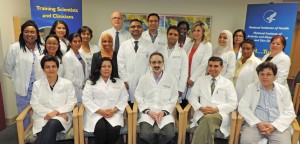
Fifteen years ago, NIAMS established its Community Health Clinic (CHC) as an extension of the NIH Rheumatology Clinical Research Program to better understand diseases such as rheumatoid arthritis and lupus and gain insights about why these and other rheumatic diseases disproportionately affect people in certain minority groups. The full-service rheumatology clinic, which has enrolled more than 2,500 patients and provided nearly 17,000 patient visits since its inception, recently relocated to the Clinical Center, enabling individuals enrolled in the “Natural History of Rheumatic Diseases in Minority Communities” protocol to receive patient care services from a centralized state-of-the-art facility.
When it opened its doors in 2001 in a medical suite at Unity Health Care Inc.’s Upper Cardozo Health Center in Northwest Washington, D.C., the CHC had already been several years in the making. Years of coordination and planning with city officials, local organizations and NIAMS and Clinical Center staff helped ensure that the clinical program was established in a way that served numerous interests all at the same time. Partners advised NIAMS on local community needs and concerns about medical research, helped reduce barriers to minority participation in clinical studies and promoted the program to the larger metro area. NIAMS, in turn, provided underserved area residents access to cutting-edge specialty care, clinical studies and health information. In addition, the CHC served as a research training facility offering rheumatology fellows across NIH a community-based learning experience in rheumatic diseases.
“The CHC has been beneficial on multiple levels,” said Dr. Richard Siegel, clinical director at NIAMS. “We have been able to serve the community while also furthering our research and training new clinician scientists. I’m pleased we have been able to keep the center active for so many years.”
Ten years after its establishment in Upper Cardozo, the CHC moved to the Spanish Catholic Center, Cardinal McCarrick Center of Catholic Charities in Silver Spring. This location enabled NIAMS to continue serving the diverse, multilingual population in the DC/VA/MD metropolitan area. Almost half of the patients speak only Spanish and three-quarters are foreign-born from more than 40 countries. The majority of the foreign-born patients are from Central America, South America or the Middle East. “We have been able to serve many people who normally would not have had access to adequate rheumatological care,” said Dr. James Katz, chief of the Rheumatology Fellowship and Training Branch, NIAMS.
Now, 5 years later, the CHC has relocated to the Clinical Center. The CHC hopes to continue to grow its program on campus while staying connected to its community roots through ongoing partnerships with primary care providers. A centralized location for clinical services allows patients easy access to the laboratory, radiology department and special consultants. And with a bilingual staff, the CHC hopes to create an atmosphere where patients feel welcome and at home at the Clinical Center. —Mimi Lising
